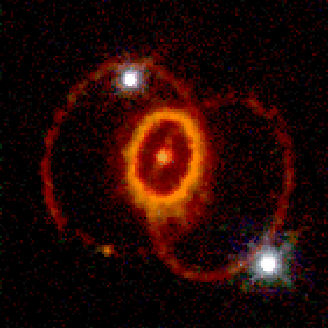
The 1987A supernova.
The composition of cosmic rays ranges from massless photons through neutrinos, photons, electrons, and protons to atomic nuclei as heavy as lead.

The 1987A supernova.

A possible black hole in the centre of the NGC4261C galaxy.
The sources of most cosmic ray particles that reach the earth are well known and include the Sun, supernovae, neutron stars, and black holes. For the most energetic ones, however, we still don't know about their origins. The only thing that seems to be certain is that they must come from beyond our own galaxy.
But cosmic rays are unpredictable and with the advent of particle accelerators, most particle physics research transferred to laboratories like CERN. Cosmic ray physics, however, is still important for energies beyond the reach of accelerators.
Nowadays, the primary goal of cosmic ray studies is to learn about the sources of the particles, the acceleration mechanisms and propagation of cosmic particles through the galaxy. Physicists also hope that new particles might be discovered in high energy cosmic ray interactions, particles that require too much energy for laboratory accelerators to make. Another strand of cosmic ray research analyses cosmic rays from particular sources to learn about what goes on inside them.
One specific goal is to identify the particles that make up the mysterious Dark Matter in the Universe. We know that visible matter accounts for just 10% of all the mass in the Universe, but so far we don't know what the other 90% is made of! Cosmic ray studies have indicated that the elusive neutrinos could have a tiny mass. If they do, they could account for a significant fraction of the Dark Matter simply because there are so many of them.
Yet another goal of cosmic ray physics is to investigate the observation that the Universe is apparently made entirely of matter, containing almost no antimatter at all. Just one atom of something like anti-oxygen detected in cosmic rays would be proof that large regions of antimatter must exist in space because an anti-star would have been needed to cook up that single anti-atom. So far no such anti-atoms have been found and physicists believe that the asymmetry between matter and antimatter arises from a slight preference that nature seems to have for matter.
In all of these questions, cosmic ray physics and laboratory-based accelerator studies play complementary roles.
Most cosmic ray particles have energies up to a few million electron Volts, 106 eV, a figure that is easily within reach of particle accelerators. Recently, however, cosmic rays with energies as high as 1020 eV have been observed. That is a colossal amount of energy, some 100 million times higher than even the most powerful particles accelerators, so these cosmic rays are generating a new wave of interest in cosmic ray physics. However, while the energies may be far beyond those available at accelerators, the rates are extremely low. Above 1018 eV we expect only one particle per square kilometre of the earth's atmosphere per week. Above 1020 eV we expect just one particle to fall on each square kilometre in 100 years!
It is difficult to imagine where such high energy particles might be coming from. Scientists have proposed ideas such as super-powerful cosmic explosions, massive black holes, and as-yet unknown giant relics from the early Universe. It's very possible that these high-energy cosmic rays hold secrets about the evolution and perhaps even of the origin of the Universe.